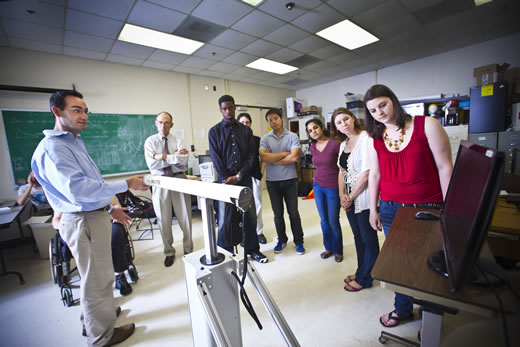This past Spring, three third-year Department of Physical Therapy (DPT) students, three engineering PhD students from the Georgia Institute of Technology and one Emory neuroscience PhD student came together for a first-of-its-kind course. Titled "Interfacing Engineering Technology and Rehabilitation," the class aimed to bridge the gap between engineering theory and rehabilitation reality.
The seeds for this novel course were planted three years ago with the Physical Therapy and Society Summit (PASS) sponsored by the American Physical Therapy Association. "One of the recommendations to come out of the Summit was the need to bridge communication and collaboration between physical therapists and bioengineers," says Steven Wolf, PhD, professor and a member of the PASS steering committee. "We felt such a collaboration should not wait until those folks are in their professional environment. Rather, it should begin in classroom."
The concept sounds great in theory, but how do you turn it into reality? Emory may be uniquely suited for the task. Over the years, Emory has built a close collaborative tie with Georgia Tech. And the Emory DPT faculty includes a member who can speak both languages – Randy Trumbower. In addition to his master’s degree in PT, Trumbower has master’s and doctoral degrees in biomedical engineering, and he has program faculty appointments in the Department of Biomedical Engineering as well as the Robotics PhD program at Georgia Tech.
Trumbower and Wolf designed the course to introduce students to the emerging trends in rehabilitation technologies. A unique feature – in addition to lectures and labs, students got to interact with actual patients, who are, after all, the real consumers of rehabilitative technologies.
For example, students met with one patient who had suffered a stroke, which affected his ability to use his arm. The students were divided up into three teams, each charged with coming up a technology to aid the patient’s rehabilitation.
"It was such a unique opportunity to collaborate with other professionals who have parallel interests but in different fields of medicine and science," says Anita Krishnan, DPT ’12. "Everyone brought a different perspective to the table."
Krishnan’s project partner, Ramaldo Martin, agrees. "The course helped me put the technology in perspective," says Martin, who is in his final year in Georgia Tech’s School of Electrical and Computer Engineering PhD program. "As an engineer, I might come up with an amazing tool, but it may not end up being used because the patient may find it too difficult to use."
This kind of conversation is exactly what Trumbower and Wolf hoped for in designing the course. "The overarching goal was to break down the inherent barriers between physical therapists and engineers," says Trumbower. "The two groups don’t often have the opportunity to interact, and when they do, they are not sure how to communicate with each other"
Trumbower and Wolf hope to expand the course to include more students, both at Emory and Georgia Tech and beyond.
Says Wolf, "We hope to be able to use this course as a model for others to build upon."

